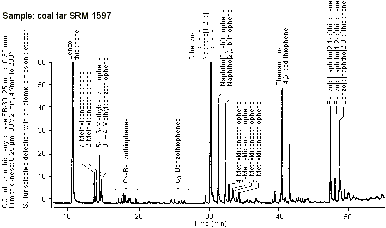Go to our PASH Catalog
Polycyclic Aromatic Sulfur Heterocycles
Reference Solutions
The analytical determination of polycyclic aromatic sulfur heterocycles (PASH) has long suffered from the fact that very few reference compounds have been commercially available until now. Nevertheless PASH are of great importance in several fields such as:
- geochemistry
- analysis of fossil fuels and oils
- environmental chemistry
- toxicology
1. Geochemistry
The distribution of monomethyldibenzothiophene isomers in crude oil provides information about the source rock of the oil origin 1. Additional information about maturity and age of the oil can be obtained by determining the ratio of the thermodynamically more stable 2- and 3-methyldibenzothiophenes to the thermodynamically less stable 1- and 4-methyldibenzothiophenes 2.
2. Fossil Fuels
The desulfurization of fossil fuels is a most important process in industry. However, while aliphatic sulfur compounds can easily be desulfurized aromatic sulfur compounds of the PASH type are quite stable 3.
3. Environmental Chemistry
PASH are released into the environment by burning organic compounds, oil spills or other industrial activities. They have been determined in several environmental samples and are certified in some standard reference materials:
4. Toxicology
Like polyaromatic hydrocarbons (PAH) some species of PASH are carcinogenic and/or mutagenic as well. For instance, phenanthro[3,4-b]thiophene was proved to be highly mutagenic 6 and benzo[2,3]-phenanthro[4,5-bcd]thiophene was found to be even more mutagenic than benzo[a]pyrene 7. However, due to the lack of suitable standard reference materials this field of research is still largely unexplored.
Example of a Gas Chromatogram 
References
[1] W. B. Hughes, in: "Petroleum Geochemistry and Source Rock Potential of Carbonate Rocks" (J. G. Palaca, Ed., AAPG, Tulsa, 1984), pp. 181-196
[2] L. Schou, M. B. Myhr, Org. Geochem. 13, 61-66 (1988)
[3] A. Attar, F. Dupuis, Adv. Chem. Ser. 192, 239 (1981)
[4] S. A. Wise, B. A. Benner, S. N. Chesler, L. R. Hilpert, C. R. Vogt, W. E. May, Anal. Chem 58, 3067-3077 (1986)
[5] S. A. Wise, B. A. Benner, G. D. Byrd, S. N. Chesler, R. E. Rebbert, M. M. Schantz, Anal. Chem 60, 887-894 (1988)
[6] J. Jacob, Sulfur analogues of polycyclic aromatic hydrocarbons (Thiaarenes), Cambridge University Press, Cambridge, 1990
[7] Karcher, A. Nelsen, R. Depaus, J. van Eijk, P. Claude, J. Jacob in: "Chemical Analysis and Biological Fate: Polynuclear Aromatic Hydrocarbons", (M. Cooke, A. J. Dennis, Eds., Batelle Press, Columbus, 1981), pp. 317-327

